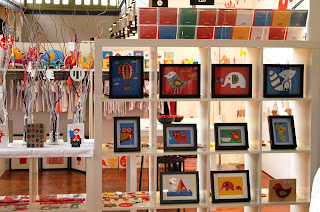Having a
trade show is a huge investment and it does not come cheap either. Besides spending
a lot of money on a booth, travel, marketing and personal costs! You just can’t depend
on promotional efforts alone to make sure your investment is worthwhile, You
really need to have a sales
& process in place at the show. Why?
If you
don't have one, the likelihood is that your prospect clients will show their
interests and spend their wallet share to your competitors.
So, how
can you get the potential customer's attention real-time and turn them into
serious prospects and buyers?
There are
Six key steps to selling at a trade show:
1. The Power
of merchandising
2. Observing
and Qualify
3. Determine
customers wants & needs
4. Offer a
solution
5. Close
the sale
6. Follow Up
The
Power Of Merchandising The power of creative visual merchandising plays a very important
role in your design business. In a highly competitive market your customers are
savvy as ever. That’s why it’s essential to make your booth experience as
appealing and engaging as possible.
Eye-catching
graphics, products and colours that out shine from the booths are the
first thing that will get the visitors' attentions. At that point they
stop to find out what product or service you provide. Make sure it’s clearly
communicated in an easy to read format, your logo & sign are clearly
visible. In less than 10 seconds, your visitors will make a decision
whether they should pop into your booth to learn more about you or by pass your
booth to somewhere else that grabs their attentions. The booth must be inviting
and ease of shopping: tables and counters at the side, avoiding a visual
barrier; no clutter. Look out for welcoming body language so that you can
connect with them.
Observing
and qualify. Visitors like to be acknowledged. When you see the person,
stop, walk over, establish eye contact, read the name badge, and greet them by
name with an open-ended question that gives you insight such as:
“Hello
Susan, what have you seen so far that interests you?” or
“What are
you hoping to get out of this show?”
Based on
the conversation, start probing to find out how the person fits into the
organisation in terms of budget and decision-making authority.
Determine customers
wants & needs. Most
visitors come to a show for a specific reason. While they may want to know
what’s new on the market, they usually have a specific want and need to solve
or a wish list to fulfil. Learn and define the 8 customer's catch and what
catch would resonate with them.
Offer a
solution. Explain
how your products or services can meet their needs or meet their budget
and their wish lists. From experience most visitors will spend no more
than 10 minutes in a booth even if they are really interested in your product
or service. The key here is to focus on what they tell you and listen to their
needs and match the solution you propose to their needs.
Call for
Action by Taking Sales/Orders. If the visitors
are really interested in your products and they indicate a buying signal,
be bold and close the sales by asking:
- Let’s take a seat and I'll write up an order for you? Or
- How about I place the order now?
Remember,
most of the buyers come with a budget in mind and their objective is to
spend money and you want to be the one taking the order at the show and not
your competitors .So be bold to ask for the sales or order from them.
Follow Up
post show. At some
point some visitors are not ready to order right at the show and you know they
are a potential client you should do the following:
- Ask for an appointment to follow up after the show.
- Don’t give out too much information or brochures so you have an excuse to follow-up later.
- Be sure the person is entered into the lead system. As soon as the person leaves your booth, make detailed notes in the lead system as to what you talked about. It’s a good idea to keep a pocket-sized notebook so you can jot down information for later.
- Classify your leads leads; Hot leads, Warm leads or Cold leads and follow up accordingly.
Here’s to
your trade show success


No comments:
Post a Comment